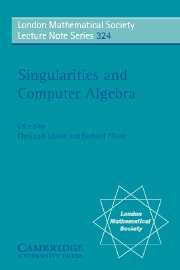Book contents
- Frontmatter
- Contents
- Preface
- Invited Lectures
- List of Participants
- Aspects of Gert-Martin Greuel's Mathematical Work
- Exterior Algebra Methods for the Construction of Rational Surfaces in the Projective Fourspace
- Superisolated Surface Singularities
- Linear Free Divisors and Quiver Representations
- Derived Categories of Modules and Coherent Sheaves
- Monodromy
- Algorithmic Resolution of Singularities
- Newton Polyhedra of Discriminants: A Computation
- Depth and Differential Forms
- The Geometry of the Versal Deformation
- 21 Years of SINGULAR Experiments in Mathematics
- The Patchworking Construction in Tropical Enumerative Geometry
- Adjunction Conditions for One-Forms on Surfaces in Projective Three-Space
- Sextic Surfaces with Ten Triple Points
- Sextic Surfaces with 10 Triple Points
- Topology, Geometry, and Equations of Normal Surface Singularities
Topology, Geometry, and Equations of Normal Surface Singularities
Published online by Cambridge University Press: 11 November 2009
- Frontmatter
- Contents
- Preface
- Invited Lectures
- List of Participants
- Aspects of Gert-Martin Greuel's Mathematical Work
- Exterior Algebra Methods for the Construction of Rational Surfaces in the Projective Fourspace
- Superisolated Surface Singularities
- Linear Free Divisors and Quiver Representations
- Derived Categories of Modules and Coherent Sheaves
- Monodromy
- Algorithmic Resolution of Singularities
- Newton Polyhedra of Discriminants: A Computation
- Depth and Differential Forms
- The Geometry of the Versal Deformation
- 21 Years of SINGULAR Experiments in Mathematics
- The Patchworking Construction in Tropical Enumerative Geometry
- Adjunction Conditions for One-Forms on Surfaces in Projective Three-Space
- Sextic Surfaces with Ten Triple Points
- Sextic Surfaces with 10 Triple Points
- Topology, Geometry, and Equations of Normal Surface Singularities
Summary
Abstract
In continuing joint work with Walter Neumann, we consider the relationship between three different points of view in describing a (germ of a) complex normal surface singularity. The explicit equations of a singularity allow one to talk about hypersurfaces, complete inter-sections, weighted homogeneity, Hilbert function, etc. The geometry of the singularity could involve analytic aspects of a good resolution, or existence and properties of Milnor fibres; one speaks of geometric genus, Milnor number, rational singularities, the Gorenstein and ℚ-Gorenstein properties, etc. The topology of the singularity means the description of its link, or equivalently (by a theorem of Neumann) the configuration of the exceptional curves in a resolution. We survey ongoing work ([15],[16]) with Neumann to study the possible geometry and equations when the topology of the link is particularly simple, i.e. the link has no rational homology, or equivalently the exceptional configuration in a resolution is a tree of rational curves. Given such a link, we ask whether there exist “nice” singularities with this topology. In our situation, that would ask if the singularity is a quotient of a special kind of explicitly given complete intersection (said to be “of splice type”) by an explicitly given abelian group; on the topological level, this quotient gives the universal abelian cover of the link.
Information
- Type
- Chapter
- Information
- Singularities and Computer Algebra , pp. 351 - 372Publisher: Cambridge University PressPrint publication year: 2006
Accessibility standard: Unknown
Why this information is here
This section outlines the accessibility features of this content - including support for screen readers, full keyboard navigation and high-contrast display options. This may not be relevant for you.Accessibility Information
- 7
- Cited by
